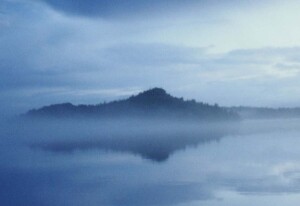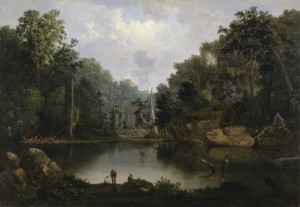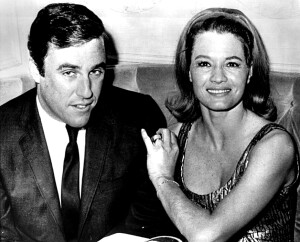by Mark Willis
1. Brendan the Navigator
When we shoved off the pebble beach, the outer islands that rim Malone Bay looked like green humped turtles on the horizon. All day long we had watched the smaller islands appear and disappear in the fog. Now the icy blue bay shimmered in hazy light. In the long midsummer dusk on Isle Royale, we had three more hours of navigable light.
I steered for open water to clear the surf zone inshore. Out there we bobbed on a slowly heaving swell, waves one to two feet. On a Coast Guard weather forecast “waves one to two feet” sounds almost like flat water; in a 17-foot canoe on Lake Superior, the sensation is more like a gentle roller coaster ride. We call it big water.
“Want to head for Wright Island?” I asked my son.
“No,” Brendan said firmly. “It’s at least a mile. I don’t want to go out that far.”
“We have to go out there half way to quarter these waves,” I told him. “We’ll swing out, then back.”
We set a westerly course midway between Wright Island and shore. I sensed something uneasy about the way Brendan hunched in his life vest. He wasn’t talking.
“Want to go for Hay Bay?” I asked, hoping that an absurd proposition would loosen him up.
“You’re crazy, Dad. Ten miles there, ten miles back — before dark? This lake could change any minute.”
He was right. First came intermittent wisps of clouds scudding across the water. The fog thickened, and five minutes later Wright Island disappeared again. Malone Bay socked in, too. Birches and spruces along its shore blurred like trees in a waterside painting by Claude Monet. Sometimes the shore was there, sometimes not. About the same time, Lake Superior’s rhythmic swell turned into an indeterminate chop.
After three Isle Royale journeys with Brendan, the first when he was nine years old, I knew we were most likely to disagree about things when paddling through chop. He read the fickle wind and waves one way, and I another. Instead of balancing forces, bow and stern clashed and our course was an unspoken dispute until one or the other or both of us yielded.
“How far do you plan to go in this?” Brendan said. It wasn’t quite a question.
“We just got started,” I said. “What’s the matter? You’ve been on big water before. Bigger than this.”
“Not in the fog. I don’t like it when I can’t even see where we started.”
I had to laugh. “But Brendan, this is what the world looks like all the time to me. Just a little fog. It’s a fine day for boating on the Great Lakes.”
Without missing a stroke he turned to dart a skeptical glance at me. Brendan the Navigator. When we named him I didn’t tell his mother everything the legendary Irish name implied. But I imagined him taking on the role of navigator for me. He was christened on Whitefish Bay, on eastern Lake Superior, when he was four weeks old. His first voyage on big water came at age 2, nested securely between my legs at the canoe’s stern. Growing up with Coastal Survey charts and tales of Great Lakes shipwrecks, he came to know Superior as another home. He never doubted the wisdom of canoeing there with a father who was half blind.
Now Brendan was 13. He knew the difference between swell and chop. He could translate a flat navigation map into the protean dimensions of no-name islands and deception bays. He could thread a canoe route between cliffs and shoals, spot a portage trail a mile across the water, scan a snag-filled cove and say with hungry satisfaction, “Hmmmm… looks pikey to me.”
I would like to claim that I taught him these things, but it didn’t happen like that. We learned together, negotiating and navigating small steps along the way. When he learned to walk he became my eyes in the woods, spotting snakes and toads and a hundred other things I would have missed by myself. When he learned to read he assumed responsibility for package labels and street signs and all the incessant visual information that drives everyday life. The teamwork we developed by finding dinner at the grocery store grew into the kind of partnership needed to find camp at Isle Royale. Two days before the fog at Malone Bay, I was amazed at my son’s surety and poise as he guided us through the clamor of the Minneapolis-St. Paul airport, navigating a course from gate 7 to gate 85 in fifteen minutes, just in time to make our connection.
Our partnership was built in small steps out of patience and trust. I questioned Brendan about what he could see, sometimes directing his attention to what I expected to be there, sometimes waiting for his reckoning of the unknown. I listened to his description of the world around us and sketched my own mental maps. As the weather deteriorated on Malone Bay, he reversed the process to probe my sense of what neither of us could see.
“OK, just a little fog,” he said. “What if it keeps getting worse and we can’t find our way back?”
“We’re heading west,” I said. “We come about and bear east.”
“What if we miss our camp? We could be out here all night.”
“Remember the big rock at the mouth of the Siskiwit River? That’s east of camp. I’ll hear the waves breaking on it. I can steer by it — and I can keep off it.”
“If we stay out here we might not make the shore at all.”
I reminded him of the compass in his pocket. “On this side of the island, bear north. You can’t miss it.”
“What if it’s too rocky to land?”
“Any port in a storm,” I said. “If we have to land we’ll do it — with or without the canoe.”
As soon as I said that I knew I should have kept my mouth shut. I reached instinctively for the throw bag clipped to my belt to make sure it was there. Brendan didn’t say anything but continued to paddle. Then our fitful passage through the chop settled back to a slow, rolling swell.
“Feel that?” I said. “I know where we are. We just cleared the lee of Wright Island. We’re on open water again.”
“Oh boy,” Brendan said flatly.
“How long was Wright Island on the map?”
“Maybe a mile.”
“Then we’re only two or three miles west of camp. No problem.”
The wind off Superior stiffened enough to scatter the fog west along the shore of Malone Bay. The waves picked up with a jolting bounce. I lifted my binoculars quickly to try to make out a landmark in the vague distance.
“I think I see a snag leaning out over the water,” I said tentatively. “Looks like light behind it, like it’s a point. Let’s go for that, then turn back.”
“Dad, there’s a lot of snags leaning out on that shore.” He knew from experience that I used such landmarks to re-negotiate final destinations.
“Look, Brendan. You know I will always defer to your judgement. You’re the navigator. If you say turn back, we turn back. But if I think we can push it a little bit farther and still be safe, I’ll always ask. What do you think?”
After a moment he said, “OK. We go for the point.”
An hour later the canoe crunched wet gravel again on our beach. Somewhere on the southern horizon, the Isle Royale Light on Menagerie Island swept a circle in the growing dark, but we couldn’t see it.
2. Letting Go of Sight
I couldn’t ask Brendan to push the limits had I not asked and done so myself hundreds of times before I ever brought him to big water. I have canoed solo on Lake Superior for almost as many years as I have been losing eyesight. I have returned to the immense lake year after year like a migrating loon to learn the other side of a slow, uncertain process that we could call “going blind.” After 25 years with the lake as my teacher, I know what lies on the other side. I call it letting go of sight.
Anyone standing on the shore of Lake Superior gets the uneasy feeling that the word lake cannot begin to contain it. Even the words inland sea feel inadequate. Lake Superior is oceanic in power and proportion. In fact, it is as close to being an ocean as fresh water gets. It is the largest, if not the deepest, body of fresh water on Earth. It is said to hold one-fifth of the planet’s fresh water at any given moment of the global hydrologic cycle. It is pulled by the moon in tides that rise and fall as much as a foot in a day. Across its widest fetch the wind can blow without obstruction for three hundred miles. Lake Superior does not have weather — Lake Superior makes it.
The first lesson I learned at the edge of this immensity was how to stand and wait. Facing a winter gale at Whitefish Point — winds northwest to 50 knots, waves 12-16 feet — I felt as small and humbled as John Milton standing before God at the conclusion of his famous sonnet. Small and humbled, yes, but not insignificant. He also serves who stands and waits. In the face of such awesome forces, responding on a scale that can only be human, patience may be the gift we bring to the table.
Even the brief respite of a Lake Superior summer requires patience. In July and August, two days out of every three, all you can do is stand on the beach and calibrate the increments of the Beaufort Wind Scale. Force 5 winds, waves 4-6 feet — complete folly to venture onto Lake Superior in an open-hulled canoe. Force 4, waves 3-4 feet — survivable if you’re already out there, running desperately for shore. Force 3, waves 2-3 feet — manageable in open water, if only you can claw your way out through the surf. Wind-bound on Lake Superior, you ask yourself over and over again, can I launch in this? Can I stand and wait another day?
My early days on Lake Superior came at Whitefish Bay, a fifty-mile expanse of “sheltered” water bounded by Whitefish Point to the northwest and Sault St. Marie to the southeast. Those familiar with the 1975 wreck of the Edmund Fitzgerald remember how the 700-foot ore carrier might not have broken in half on hundred-foot waves, drowning all 29 of its crew, had it made ten more miles to Whitefish Point. The wide bay itself is a harbor for the largest ships in Superior’s most violent storms, but it remains inhospitable to most smaller craft. Great Lakes cruising guides note that the scarcity of marinas and harbors of refuge make eastern Lake Superior a difficult place for pleasure boaters. If your taste runs to the elan of sailing yachts or the speed and noise of runabouts and jet skis, Whitefish Bay can be a desolate place. The absence of other marine traffic makes it an ideal place for a half-blind canoeist.
Along the south shore of Whitefish Bay, about midway between the Sault and Paradise, Michigan, there is a national forest campground called Bayview. You can pitch a tent there in a grove of pines, paper birches, and young red oaks overlooking a barren white sand beach. The beach stretches seven miles from west to east, from Salt Point to Nodaway. This gently curving lip of sand and water is called Pendills Bay. Set back less than a mile from the larger bay, it is a shelter within a shelter where I learned the permutations of big water in small, humble steps.
When I imagine Whitefish Bay and Pendills Bay I move from west to east along a deeply internalized map. In the course of a day there the weather gauge can swing wildly through every quarter of the compass, but the prevailing winds are westerly. As I began to map this coast I reversed directions, paddling west into the wind. That was the second lesson I learned on Lake Superior. If you set out in the morning with the wind at your back, it can carry you farther than you can safely return facing it, fatigued at the end of the day. When I paddle a canoe solo, I steer by the wind, either quartering or beating into it head on. My body turns windward instinctively, a response in the muscles and nerves not unlike the positive rheotaxis that keeps a trout’s nose pointing upstream, even when it rests.
A canoe is like a long finger testing the wind. It magnifies the slightest shifting breeze. I feel the change of motion first in my thigh, which I brace for purchase against the gunwale opposite the side where I paddle. Wind tugs me and the boat this way or that, sometimes imperceptibly, and I shift my balance and paddle stroke to accommodate it, often without thinking. In a canoe the paddler’s body is like a mast with sails; you tune the rig continuously as you move through water and wind. When you can do this without thinking about it you become another animal on the water, like a loon or cormorant or an otter. Even a water snake, with only its head surfacing as it undulates through a lake, contends with the same balance of wind, waves, and animal locomotion.
Live your life in the wind and eventually you discover that you have learned things you didn’t think you could know. You feel the differences between wind blowing across deep water and wind combing shoals. You feel the subtle gradation of sand bars beneath you, and the emphatic discontinuities of rocks. You hear the differences, too. Over time your body absorbs this knowledge, remembers it, and responds accordingly. You begin to know the rhythms of big water in a place like Pendills Bay. Your body begins to match those rhythms, and you trust yourself to set a course and judge the distance by the cumulative feel of the wind. One day you find that you’ve made your way expeditiously from point A to point B without really seeing what lies in between.
Combining a knowledge of time and place with the feel of wind and water currents is the ancient art of dead reckoning. Mariners used this art for centuries before the advent of navigation aides like the compass, sextant, and chronometer. Dead reckoning took the Innuit from the Bering Straits to Baffin Island along the edge of the Arctic Ocean, one of the most treacherous coasts imaginable. Polynesians followed it as they populated Oceania, a handful of tiny islands flung across five thousand miles of the South Pacific. On his first three voyages to the New World, Christopher Columbus’s dead reckoning carried him back to Europe against prevailing winds, each time making the same projected landfall off Portugal’s Cape St. Vincent. From the vantage of computer-based navigation technology like LORAN-C and the Global Positioning System (GPS), dead reckoning sounds like primitive mysticism. It does require an intuitive leap of faith to trust it, but it also represents a complex array of learned skills perfected when humans had little other information to distract their senses.
At Whitefish Bay, on that one summer day in three when you can launch a canoe safely, the wind sometimes ceases completely. Lake Superior stretches like blue glass to the horizon, and you tell yourself that if there is violence and tumult one day, there is grace and perfection another. If the day is calm and clear, Superior’s rarest weather, sunlight penetrates the cold crystalline waters to a depth you probably have never seen before. Most of the time, however, calm water means fog.
I learned to love the fog for as long as it lasted. Sometimes it was so thick that all I could see was a strip of sand and dark water fifty yards before me. The water was so calm I could paddle close to shore, with only a few feet of it below me, where a canoe would be pounded by surf on a windier day. Then I would hug the shore for miles, dipping and pulling my paddle as quietly as I could, and the only sounds I heard were birds in the fog-shrouded forest and the ripple of my own bow wave. I like to imagine how the Anishinaabeg, who taught the Voyageurs after them, plied these waters in birch-bark canoes. Journeying four hundred miles from one end of the great lake to the other, their best days must have unfolded in the fog, when they were seldom more than a stone’s throw from the trees that made their boats.
3. Listening to Loon Woman
In early August loons that nested on inland lakes across Michigan’s Upper Peninsula begin to gather in migratory flocks on Lake Superior. To me, the surest sign of calm water is the wailing of loons close inshore. In the same way that calm water looks like a mirror, it also reverberates sound like a ring in a bell. Water modulates the sounds of loons in myriad ways. When a loon calls on the wing the sound is different from when it is bobbing in the swell or floating placidly on flat water. When we hear loons we tend to project human feelings into their tremolos and wails. We think they are saying, “I am lonely, where are you?” or “Come here, the fishing is good.” One loon calling to another on a distant bay reveals more than its relative position. The timbre and modulation of its call says something about the immediacy of wind and water conditions. That is what loons say to me.
Early one August morning I woke to the wailing of a cacophony of loons at Bayview. I crawled out of the tent, grabbed binoculars and last night’s leftover coffee, and stumbled barefoot to the beach to see if I could spot them. I knew they were just offshore, but in the indistinct light known as false dawn, I saw nothing but fog where Lake Superior should be. The sound beckoned, so I flipped my canoe over, dragged it across the sand, and launched silently into still water. I followed one loon, then another, all of us invisible in the fog. At some point as wet sand dried on my legs I shivered a little and wondered if I were re-enacting a primordial Anishinaabeg myth — the one in which a foolish hunter falls in love with Loon Woman. He wakes up one morning in an other-worldly palace at the bottom of the lake and finds he cannot return to his home on land.
I can’t say how long I carried on like this, following Loon Woman in the fog, but as false dawn turned true there was light but no more visibility. It may be apocryphal, but once at a time like this the mountain man Jim Bridger said, “I wasn’t lost. I just didn’t know where I was for two or three years.” Eventually the glassine water beneath me began to heave with the slightest swell. The swell built slowly into a rhythm I recognized. I knew where I was then, and I was terrified.
The loons tempted me no farther. I stopped paddling and took stock of my situation. I had half a pot of cold coffee, 7x binoculars, and no compass. Leaving camp without a compass was the stupidest thing I’d ever done, and I swore I’d never do it again. In a dead calm the swell had to mean that I had passed both Salt and Nodaway Points. I had left the relative shelter of Pendills Bay. Now I was afloat on really big water more than a mile, maybe two miles, from shore. I searched my memory for details of the navigation chart for Whitefish Bay. The water out here might be 300 feet deep. I might be drifting into the ship channel; the wake from one of those big boys could sink a canoe at half a mile. I slipped into the red life vest that had been lashed to the canoe seat when I left shore.
The fog lifted slowly that morning. The sky remained overcast with low rain clouds, so there was no sun to steer by. I scanned the horizon in all directions. With limited eyesight, binoculars are but a crude visual aid for me. Instead of bringing distant points into sharp focus, they help to amplify my perception of light, shadows, and motion across my field of vision. All I saw was horizon, no differentiation between land and water. I had paddled beyond my sight of land. If I continued to struggle to see, I would panic. There was no other choice but to let go of sight and wait for something else to happen.
I listened then with all the attention my ears could muster. If I heard the thrum of big diesels out there on the water, I’d bolt in the opposite direction. If I heard wayward loons or gulls I’d ignore them. I listened for the raucous jabber of a raven perched in a cedar tree. I wanted to smell bacon frying at someone’s camp. I’d take any cue I could trust to lead me back to shore.
When it came, finally, the sound was low, barely audible, unmistakably groaning under great weight. It dropped abruptly in pitch, then climbed at jagged intervals. Ships’ engines are slow and steady; they don’t sound like that. It had to be a big truck grinding through its crawler gears. I remembered the huge 12-yard dump trucks rumbling past Bayview, hauling gravel to Paradise. Yesterday the noise was infuriating; today I could have kissed this truck. It had to be climbing a hill on the Curley Lewis Highway about five miles west of camp. I swung the canoe south by southeast and steered by the sound, paddling with all my heart. That way was home.
Note: The Ohio Arts Council awarded the author an Individual Artist Fellowship for this essay in 2000.


![Sandhill cranes land on Platte River sandbar roosts west of Rowe Sanctuary’s Iain Nicolson Audubon Center southwest of Gibbon, Nebraska. [Photo by Lori Porter| Kearney Hub]](https://www.ghostturtles.com/wp-content/uploads/2015/03/sandhill_cranes_kearneyhub_032015-300x225.jpg)
![An endangered Whooping crane takes flight. Yhe large bird has a 7-foot wingspan. It is all white except for black wing tips and face markings. In this photo its long neck stretches forward; its wings sweep upward; and its black legs trail straight behind it. [Source: International Crane Foundation]](https://www.ghostturtles.com/wp-content/uploads/2023/03/Whooping-crane-eastern-ICF-080622-300x157.jpg)

![Mark Willis peruses a 1745 volume by Voltaire at a bouquiniste book stall on the banks of the Seine in Paris. He wears a brown leather jacket and checkered flat cap. He holds the open book in his hands. Rows of old books are seen on shelves behind him. [2005 photo by Ms. Modigliani]](https://www.ghostturtles.com/wp-content/uploads/2023/03/mw_bouquiniste_05-300x225.jpg)


